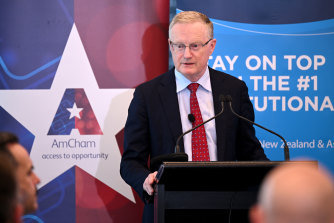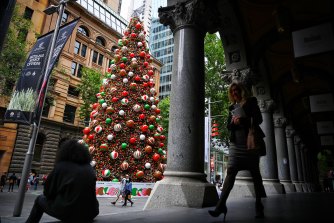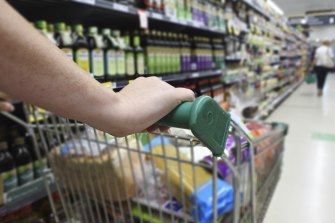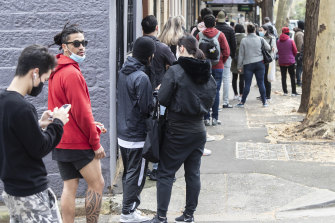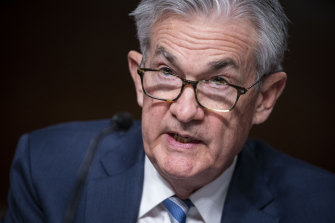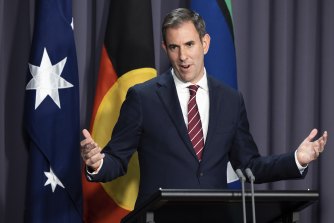By Shane Wright
Like a tightrope walker about to take their first steps across a chasm, Reserve Bank governor Philip Lowe can see his goal – and the danger beneath his feet.
He, like central bankers around the world, are all heading out onto a very thin wire balancing the need for strong economic growth on one hand with the battle to bring inflation under control on the other.
Reserve Bank governor Philip Lowe this week outlining the case for higher interest rates.Credit:AAP
Speaking this week about the situation facing the Reserve Bank, and through it, the Australian economy, Lowe conceded the way ahead was not for the faint-hearted, especially for those who may have a job.
“It’s a fairly narrow path we’re on. We’re trying to get demand and supply to increase at the same rate and achieving that’s difficult,” he said.
“It’s quite possible that at some point in time the unemployment rate will rise, but I don’t think it needs to rise.”
While Lowe’s words are often parsed to understand what the RBA’s interest rate settings may mean for home buyers, little was said about these utterances.
But they went to the heart of the problem facing Lowe and other central banks. After spending the COVID recession using policy to drive unemployment down to the lowest level in half a century, people may lose their jobs as the bank tries to take inflationary pressures out of the economy.
To bring inflation to heel (currently 5.1 per cent and now likely on its way to 7 per cent by year’s end), the RBA is increasing interest rates.
It’s already taken the cash rate from 0.1 per cent to 0.85 per cent at its past two meetings. When board members sit down on July 5 for their next meeting, they will debate whether to hike rates by either a quarter of a percentage point or a half.
Apart from making your home loan repayments more expensive, higher interest rates have a much broader economic impact.
The NSW Treasury this week gave some insight into what higher interest rates may mean. In sensitivity analysis released as part of the state budget, it looked at the economic fallout from interest rates running about a percentage point higher than Treasury expects.
It expects the RBA to have official interest rates at 1.75 per cent by year’s end and 2.5 per cent by the end of 2023. But financial markets reckon they could be closer to 4 per cent just as Australians are decorating their Christmas trees.
So, the NSW Treasury had a look at what might transpire if its assumptions prove to be wrong.
Official interest rates could be well above 2 per cent by Christmas.Credit:Nick Moir
It found the state economy would be 0.9 percentage points smaller than expected, employment growth would be 0.3 percentage points lower in 2022-23 and 0.4 percentage points lower the following year while the jobless rate would be higher across the next four years.
Wages growth would be slower while inflation in Sydney would be about a half percentage point lower.
“Overall, this means consumers will spend less and businesses will invest less, leading to a reduction in domestic economic activity and, consequently, lower employment,” it found.
Replicate that across the country, and you’re talking about 100,000 or more people out of work. It means fewer small businesses. It means tens of thousands of first-time home buyers owing more on their property than it’s worth.
This is not just an Australian problem.
Central banks around the world, which slashed interest rates to zero or lower while creating trillions of dollars as part of quantitative easing programs, are rapidly reversing direction.
Last week, America’s central bank increased official interest rates there by 0.75 percentage points with more increases to come.
Inflation is pushing up prices for everyday goods, forcing Australians to consider reducing their spending on things like chocolate snacks.Credit:Getty Images
This week, the Bank of England got a sharp wake-up call with inflation across Britain climbing to 9.1 per cent. Its job is to have inflation around 2 per cent.
Britain’s official interest rate is at 1.25 per cent, but it will be pushed much higher at its early August meeting.
The central banks of Europe, New Zealand and Canada are all increasing their interest rates.
One senior global economist told The Sydney Morning Herald and The Age that the current situation is a “first-order global challenge”.
All of these central banks have the same goal – achieving a so-called “soft landing” for their economies. But saying soft landing is much easier than actually achieving one.
The RBA does have history on its side when it comes to Lowe’s high wire act.
Apart from one glaring mistake (which directly contributed to the 1990-91 recession), the Reserve Bank has a pretty reasonable track record when it comes to increasing interest rates without flattening the economy.
In 1994, over a five-month period, the RBA lifted interest rates by 2.75 percentage points. It remains the most aggressive tightening of monetary policy over the past 30 years.
People outside a Centrelink office early in the COVID recession. Higher interest rates often contribute to a lift in unemployment.Credit:Louie Douvis
While this episode caused political problems for then prime minister Paul Keating, the economy withstood the lift in rates. Unemployment actually edged down through the period (albeit it was still in the high-8s).
Ahead of the dot.com global slowdown in 2000, the bank lifted the cash rate by 1.5 percentage points. The rest of the world went into recession, but Australia narrowly avoided one although on this occasion the national jobless rate did appreciably lift.
The next tightening of interest rates was done in slow motion.
Between 2002 and 2008, the bank made a dozen quarter percentage point increases that took the cash rate to a pre-Global Financial Crisis level of 7.25 per cent. Again, the economy withstood the bank’s policy tightening with the jobless rate actually falling to 4 per cent.
After slashing rates through the GFC, the bank then took the cash rate from 3 per cent to 4.75 per cent between 2009 and 2010. Unemployment fell through this period (but did not get back to its pre-GFC level).
There have been failures. Interest rates kept going up through the early 1980s recession, adding to the pain that left unemployment above 9 per cent for more than 18 months.
And, most famously, the bank had interest rates around 17 per cent in early 1990. The jobless rate would climb from 5.5 per cent in November 1989 to 11 per cent in November 1991.
This time around, the starting points are rather different. Never before has the Reserve Bank had official interest rates so low. Never before has it also been ending a quantitative easing program.
It’s been decades since inflation has been so high.
And never before have home buyers been carrying so much debt. Already, the 0.75 percentage point increase in interest rates has translated into an extra $321 a month in repayments on an $800,000 mortgage.
If the bank goes through with another half percentage rate rise next month, those repayments would be $544 a month up on where they were in April. By any measure, that’s a steep increase for a mortgage-mad population that had not seen a rate rise in a dozen years.
Westpac’s economics team this week said they believed the cash rate could be at 2.6 per cent by February. Someone with an $800,000 mortgage would be $1200 worse off relative to where they were in April.
BetaShares chief economist David Bassanese notes the adage that when America sneezes, Australia catches a cold.
He says the fall in consumer sentiment over recent months plus the weakening in local house prices presents a portent of what might be around the corner.
“While I am still hopeful the Australian economy can avoid recession, it is at least a 40 per cent risk in the coming 12 months,” he says.
Goldman Sachs analysts this week put the chance of a recession in America next year at 30 per cent, so Australia won’t be alone if that’s what transpires.
The head of America’s Federal Reserve, Jerome Powell, on Thursday morning Australian time told a Congressional hearing that his efforts to bring inflation under control could leave the world’s largest economy in recession.
Federal Reserve chairman Jerome Powell this week admitted the US could end up in a recession due to higher interest rates.Credit:Al Draog
“It’s not our intended outcome at all, but it’s certainly a possibility,” he said.
“We are not trying to provoke and do not think we will need to provoke a recession, but we do think it’s absolutely essential (to bring down inflation).”
His Australian counterpart was asked a similar question by journalists this week.
Lowe pointed to the ultra-low jobless rate and the strong prices Australia is receiving for its key exports as evidence that a local recession is unlikely.
“Australia has a lot of positives and so we don’t see a recession on the horizon,” he said.
“But the last two years has taught us anything we can’t, you know, you can’t rule anything out, but our fundamentals are strong.”
Those fundamentals, of course, have been underpinned by sky-high commodity prices (driven in part by the war in Ukraine), record-low interest rates and plenty of COVID-related financial support from governments.
Not only does the Reserve Bank need to negotiate domestic economic issues, it has to do it while other central banks battle their own inflation dragons.
Australia’s cash rate at 0.85 per cent is well short of its international peers. Across the Tasman, the New Zealand central bank has interest rates at 2 per cent.
The global chief economist at Citigroup, Nathan Sheets, says there are risks across the world.
“Our view is that the global economy is flashing a number of yellow lights at present, which flow from the persistent supply shocks but also increasingly from central bank tightening and the effects of tighter financial conditions and higher inflation on the behaviour of consumers,” he recently noted.
A measure of consumer actions from the NAB noted people are turning off lights, ditching their gym memberships and even going without their afternoon chocolate snack to deal with inflation.
Citigroup, one of the world’s largest banks, has downgraded its forecasts for the world economy including Australia. It expects the RBA to have interest rates at 2.6 per cent by the end of his year and then 3.1 per cent next year.
The consequence of such tight monetary policy would be a jobless rate of 4.75 per cent by the end of 2023 while economic growth would “muddle along” at a pre-COVID rate of 2 per cent.
Treasurer Jim Chalmers noted to his departmental staff this week that newspaper cartoonists and some commentators believe the new government has been delivered an economic “shit sandwich”.
Treasurer Jim Chalmers said this week there were reasons to be optimistic about the economy while outlining a long list of reasons to be concerned.Credit:Alex Ellinghausen
He disagrees, saying Australians had cause to be optimistic. But he also delivered a long line of reasons to believe the sandwich he and the Albanese government is being asked to swallow will be particularly unpalatable.
“We do have high and rising inflation, rising interest rates, falling real wages, a heap of debt in the budget, and those are all real challenges, of course, that we need to help to address,” he acknowledged.
“And we’ve had some of those longer-term pressures as well, around productivity, around business investment.”
Whether the food improves on the Chalmers’ dinner plate depends much on whether Lowe and other policymakers around the world manage to cool their economies without crashing them.
A senior global economist, speaking on the condition of anonymity, likens the situation facing all central banks to a helicopter pilot.
“They’re trying to land a helicopter, on a ship in the ocean, in the middle of the night,” he says.
These are the options ahead of Lowe, the rest of the central bank, the federal and state governments – splattered at the bottom of a chasm after falling from the high wire, or blown to bits of twisted metal on a dark ocean. Neither are appealing.
The Business Briefing newsletter delivers major stories, exclusive coverage and expert opinion. Sign up to get it every weekday morning.
Most Viewed in Politics
Source: Read Full Article
